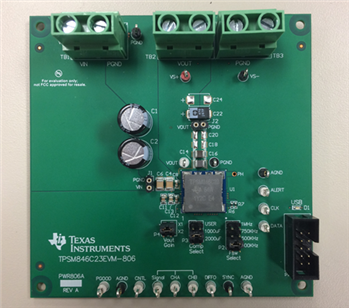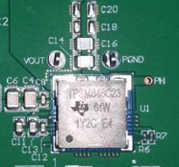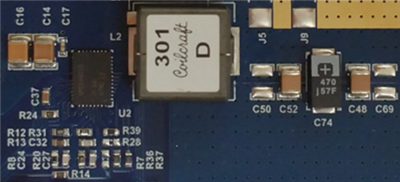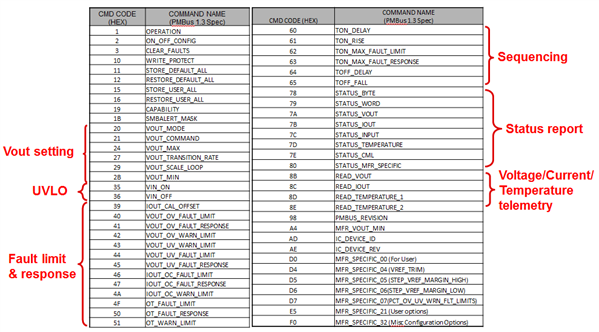SSZTAB0 march 2017 TPS546C23 , TPSM846C23

Engineers face many difficult challenges when designing power supplies for industrial and communication systems. A typical system can include one or more field-programmable gate arrays (FPGAs), application-specific integrated circuits (ASICs), systems-on-chip (SoC), networking and communication processors, or other types of processors. Each processor typically requires complex power management of multiple rails (four, 10 or more) for proper operation. The core voltage rail of the processor can often require 20A or more of current. Managing the core rail and all of the auxiliary voltage rails is a huge challenge. In addition, printed circuit board (PCB) space is limited due to shrinking system form factors, so engineers must use high-density solutions.
PMBus-enabled DC/DC converters are becoming a popular option over traditional analog DC/DC to solve these challenges. But because PMBus adds an extra layer of design complexity, many engineers are seeking solutions when implementing PMBus in a system to make things a bit easier.
PMBus is a digital communication standard that enables digital control of a DC/DC converter. PMBus is available in different versions and manufacturers have flexibility in selecting the supported commands. A PMBus-enabled device may offer the ability to set the output voltage to a complete command set that enables margining, output current readings, adaptive voltage scaling (AVS) and adjustable device functionality. PMBus eliminates the external components typically used to program these features which reduce your bill-of-materials. In newer versions of PMBus, AVS can dynamically adjust the output voltage based on processor power demand to boost efficiency.
DC/DC modules with PMBus make designs easier and reduce the power-supply footprint. DC/DC modules help designers get to market faster by simplifying power management; you do not need to be a power expert to design a small solution and meet critical specifications. Traditional PMBus modules solved challenges but were often much more bulky than a custom-designed solution using a DC/DC converter. Some of the new module offerings are smaller than the custom-designed solutions.
Shown in Figure 1, the new TPSM846C23 35A PMBus module reduces the compensation design, eliminates inductor selection, and guarantees performance compared to the TPS546C23 DC/DC converter shown in Figure 2. The TPSM846C23 achieves a smaller footprint by hiding the IC and passives underneath the inductor in a 15mm-by-16mm-by-5.8mm package to deliver an incredible density of 146mA/mm2. Two of these modules, when sharing current, deliver as much as 70A of output current. The TPSM846C23 is ideal if space and time saving is critical and TPS546C23 is ideal if cost or design optimization is critical.
 Figure 1 The 4.5V-15V, 35A TPSM846C23
PMBus Stackable Synchronous Buck Module
Figure 1 The 4.5V-15V, 35A TPSM846C23
PMBus Stackable Synchronous Buck Module Figure 2 The 4.5V-18V, 35A TPS546C23
PMBus Stackable Synchronous Buck Converter
Figure 2 The 4.5V-18V, 35A TPS546C23
PMBus Stackable Synchronous Buck ConverterThe TPSM846C23 uses the PMBus v1.3 command set with telemetry features for maximum configurability and design flexibility. With this command set, you can program sequencing, customize device performance and protection, read output current and operating temperature, and implement AVS (Figure 3).
 Figure 3 TPSM846C23 PMBus Commands
Supported
Figure 3 TPSM846C23 PMBus Commands
SupportedTo ease the design process, TI’s implementation of the TPSM846C23 in WEBENCH has support for AVS, output-voltage transition rate, undervoltage lockout and soft start through PMBus. For full prototyping of PMBus, the TPSM846C23 evaluation module is supported by the Fusion graphical user interface (GUI). TI’s Fusion GUI configures and monitors the TPSM846C23. Fusion GUI uses the PMBus protocol to communicate with the TPSM846C23 over serial bus by way of a TI USB adapter.
You can see a live demonstration of the TPSM846C23 high-current PMBus power module with telemetry in TI’s booth, No. 701, at the Applied Power Electronics Conference (APEC) March 26-30 in Tampa, Florida.
In the demonstration, you’ll be able to see how the module’s PMBus compatibility enables output voltage, current and junction temperature telemetry, each of which is displayed in real time on the computer interface. The module is controllable through Fusion GUI that allows users to enable or disable the device, and also allows soft start and soft stop. The solution primarily targets enterprise and communication applications.
Additional Resources
- Learn more about TI’s presence at APEC.
- For more information on the topic of PMBus, read “A PMBus™ primer: common PMBus questions answered.”
- Check out TI’s power module product portfolio.